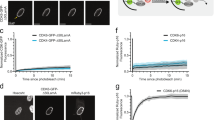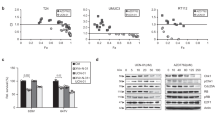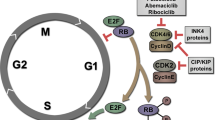Abstract
Inactivation of the retinoblastoma (Rb) protein caused by gene mutation, association with oncoproteins from small DNA viruses, mutational inactivation of p16Ink4a, or overexpression of cyclin D is a common feature of many human cancer cells and is causally associated with the aberrant proliferation control of cancer cells; whereas normal cells maintain an integrated cell cycle machinery and are subject to cell cycle checkpoint control by cyclin-dependent kinase (CDK) inhibitors (CKIs). To determine whether this difference can be translated into a therapeutic advantage to protect normal cells from adverse cytotoxicity caused by chemotherapy, we established cell model systems for ecdysone-inducible expression of p16Ink4a, p21Waf1, and p27Kip1 in one CKI-responsive cell line (A431 human vulvar epidermoid carcinoma cells with functional Rb) and one CKI-unresponsive cell line (SiHa human cervical cancer cells with nonfunctional Rb). Expression of p16Ink4a, p21Waf1, or p27Kip1 in both SiHa and A431 cells strongly inhibited CDK2 activity, indicating functional expression of the CDK inhibitors in both cell lines. However, only in A431 cells did expression of p16Ink4a, p21Waf1, or p27Kip1 cause Rb dephosphorylation, arrest cell cycle traversal, and potently inhibit cell proliferation. Induction of p16Ink4a, p21Waf1, or p27Kip1 in SiHa cells failed to cause Rb dephosphorylation or to arrest cell cycle traversal, and such induction only minimally inhibited cell proliferation. We then compared the chemosensitivity of clones derived from these two cell lines when the CKIs were and were not induced. Induction of p16Ink4a, p21Waf1, or p27Kip1 conferred strong resistance to paclitaxel- or cisplatin-mediated cytotoxicity on the CKI-responsive A431 cells but not on the CKI-unresponsive SiHa cells. Our results support a novel chemotherapy strategy for treating patients with Rb pathway-impaired cancers by concurrent administration of chemotherapy with CKIs as chemoprotective agents for normal cells.
This is a preview of subscription content, access via your institution
Access options
Subscribe to this journal
Receive 50 print issues and online access
$259.00 per year
only $5.18 per issue
Buy this article
- Purchase on Springer Link
- Instant access to full article PDF
Prices may be subject to local taxes which are calculated during checkout






Similar content being viewed by others
Abbreviations
- Rb:
-
retinoblastoma protein
- CDK:
-
cyclin-dependent kinase
- HPV:
-
human papilloma virus
- GST-Rb:
-
glutathione S-transferase-Rb fusion protein
References
Baker CC, Phelps WC, Lindgren V, Braun MJ, Gonda MA, Howley PM . 1987 J. Virol. 61: 962–971
Berezutskaya E, Bagchi S . 1997 J. Biol. Chem. 272: 30135–30140
Berezutskaya E, Yu B, Morozov A, Raychaudhuri P, Bagchi S . 1997 Cell Growth Differ. 8: 1277–1286
Boyer SN, Wazer DE, Band V . 1996 Cancer Res. 56: 4620–4624
Chou JL, Fan Z, DeBlasio T, Koff A, Rosen N, Mendelsohn J . 1999 Breast Cancer Res. Treat. 55: 267–283
Darzynkiewicz Z . 1995 J. Cell Biochem. 58: 151–159
Davis ST, Benson BG, Bramson HN, Chapman DE, Dickerson SH, Dold KM, Eberwein DJ, Edelstein M, Frye SV, Gampe Jr RT, Griffin RJ, Harris PA, Hassell AM, Holmes WD, Hunter RN, Knick VB, Lackey K, Lovejoy B, Luzzio MJ, Murray D, Parker P, Rocque WJ, Shewchuk L, Veal JM, Walker DH, Kuyper LF . 2001 Science 291: 134–137
Dellas A, Schultheiss E, Leivas MR, Moch H, Torhorst J . 1998 Anticancer Res. 18: 3991–3998
Dyson N, Howley PM, Munger K, Harlow E . 1989 Science 243: 934–937
Fan Z, Lu Y, Wu X, DeBlasio A, Koff A, Mendelsohn J . 1995 J. Cell Biol. 131: 235–242
Fueyo J, Gomez-Manzano C, Puduvalli VK, Martin-Duque P, Perez-Soler R, Levin VA, Yung WK, Kyritsis AP . 1998 Int. J. Oncol. 12: 665–669
Funk JO, Galloway DA . 1998 Trends Biochem. Sci. 23: 337–341
Huang S, Wang NP, Tseng BY, Lee WH, Lee EH . 1990 EMBO J. 9: 1815–1822
Jones DL, Alani RM, Munger K . 1997 Genes Dev. 11: 2101–2111
Jones DL, Munger K . 1996 Semin. Cancer Biol. 7: 327–337
Jones RE, Wegrzyn RJ, Patrick DR, Balishin NL, Vuocolo GA, Riemen MW, Defeo-Jones D, Garsky VM, Heimbrook DC, Oliff A . 1990 J. Biol. Chem. 265: 12782–12785
Kapoor M, Lozano G . 1998 Proc. Natl. Acad. Sci. USA 95: 2834–2837
Kohn KW, Jackman J, O'Connor PM . 1994 J. Cell Biochem. 54: 440–452
Kwok TT, Mok CH, Menton-Brennan L . 1994 Cancer Res. 54: 2834–2836
Ludlow JW, Skuse GR . 1995 Virus Res. 35: 113–121
Morgan DO . 1995 Nature 374: 131–134
Morozov A, Shiyanov P, Barr E, Leiden JM, Raychaudhuri P . 1997 J. Virol. 71: 3451–3457
Munger K, Scheffner M, Huibregtse JM, Howley PM . 1992 Cancer Surv. 12: 197–217
Ruan S, Okcu MF, Ren JP, Chiao P, Andreeff M, Levin V, Zhang W . 1998 Cancer Res. 58: 1538–1543
Scheffner M, Werness BA, Huibregtse JM, Levine AJ, Howley PM . 1990 Cell 63: 1129–1136
Schmidt M, Lu Y, Liu B, Fang M, Mendelsohn J, Fan Z . 2000 Oncogene 19: 2423–2429
Schmidt M, Lu Y, Parant JM, Lozano G, Bacher G, Beckers T, Fan Z . 2001 Mol. Pharmacol. in press
Sherr CJ . 1994 Trends Cell Biol. 4: 15–18
Sherr CJ . 1996 Science 274: 1672–1677
Sherr CJ . 2000 Cancer Res. 60: 3689–3695
Sherr CJ, Roberts JM . 1999 Genes Dev. 13: 1501–1512
St Croix B, Florenes VA, Rak JW, Flanagan M, Bhattacharya N, Slingerland JM, Kerbel RS . 1996 Nat. Med. 2: 1204–1210
Stone S, Dayananth P, Kamb A . 1996 Cancer Res. 56: 3199–3202
Verlhac MH, Kubiak JZ, Clarke HJ, Maro B . 1994 Development 120: 1017–1025
Vousden KH . 1995 Semin. Cancer Biol. 6: 109–116
Waldman T, Zhang Y, Dillehay L, Yu J, Kinzler K, Vogelstein B, Williams J . 1997 Nat. Med. 3: 1034–1036
Weinberg RA . 1991 Science 254: 1138–1146
Weinberg RA . 1995 Cell 81: 323–330
Wiman KG . 1993 FASEB J. 7: 841–845
Wu X, Rubin M, Fan Z, DeBlasio T, Soos T, Koff A, Mendelsohn J . 1996 Oncogene 12: 1397–1403
zur Hausen H . 1996 Biochim. Biophys. Acta 1288: F55–F78
Acknowledgements
Mathias Schmidt was supported by a fellowship from the Ernst Schering Research Foundation, Berlin, Germany. The authors are grateful to Mr Michael Worley of the Department of Scientific Publications for editorial assistance with the manuscript. This study was supported in part by the NCI cancer center core grant (CA16672), a research award from Bristol-Myers Squibb Company, and a start-up fund to Z Fan by The University of Texas MD Anderson Cancer Center.
Author information
Authors and Affiliations
Corresponding author
Rights and permissions
About this article
Cite this article
Schmidt, M., Fan, Z. Protection against chemotherapy-induced cytotoxicity by cyclin-dependent kinase inhibitors (CKI) in CKI-responsive cells compared with CKI-unresponsive cells. Oncogene 20, 6164–6171 (2001). https://doi.org/10.1038/sj.onc.1204814
Received:
Revised:
Accepted:
Published:
Issue Date:
DOI: https://doi.org/10.1038/sj.onc.1204814
Keywords
This article is cited by
-
Role of hepatocyte nuclear factor 4 alpha in cell proliferation and gemcitabine resistance in pancreatic adenocarcinoma
Cancer Cell International (2019)
-
The differential susceptibilities of MCF-7 and MDA-MB-231 cells to the cytotoxic effects of curcumin are associated with the PI3K/Akt-SKP2-Cip/Kips pathway
Cancer Cell International (2014)
-
Notch signaling in glioblastoma: a developmental drug target?
BMC Medicine (2010)
-
Paclitaxel combined with siRNA targeting HPV16 oncogenes improves cytotoxicity for cervical carcinoma
Cancer Gene Therapy (2009)
-
Histone deacetylase inhibitors specifically kill nonproliferating tumour cells
Oncogene (2004)



